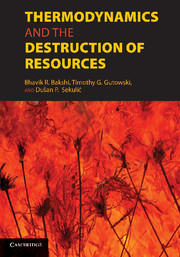Book contents
- Frontmatter
- Contents
- Contributor List
- Foreword by Herman E. Daly
- Foreword by Jan Szargut
- Preface
- Introduction
- PART I FOUNDATIONS
- PART II PRODUCTS AND PROCESSES
- 4 Materials Separation and Recycling
- 5 An Entropy-Based Metric for a Transformational Technology Development
- 6 Thermodynamic Analysis of Resources Used in Manufacturing Processes
- 7 Ultrapurity and Energy Use: Case Study of Semiconductor Manufacturing
- 8 Energy Resources and Use: The Present Situation, Possible Sustainable Paths to the Future, and the Thermodynamic Perspective
- PART III LIFE-CYCLE ASSESSMENTS AND METRICS
- PART IV ECONOMIC SYSTEMS, SOCIAL SYSTEMS, INDUSTRIAL SYSTEMS, AND ECOSYSTEMS
- Appendix: Standard Chemical Exergy
- Index
- References
8 - Energy Resources and Use: The Present Situation, Possible Sustainable Paths to the Future, and the Thermodynamic Perspective
Published online by Cambridge University Press: 01 June 2011
- Frontmatter
- Contents
- Contributor List
- Foreword by Herman E. Daly
- Foreword by Jan Szargut
- Preface
- Introduction
- PART I FOUNDATIONS
- PART II PRODUCTS AND PROCESSES
- 4 Materials Separation and Recycling
- 5 An Entropy-Based Metric for a Transformational Technology Development
- 6 Thermodynamic Analysis of Resources Used in Manufacturing Processes
- 7 Ultrapurity and Energy Use: Case Study of Semiconductor Manufacturing
- 8 Energy Resources and Use: The Present Situation, Possible Sustainable Paths to the Future, and the Thermodynamic Perspective
- PART III LIFE-CYCLE ASSESSMENTS AND METRICS
- PART IV ECONOMIC SYSTEMS, SOCIAL SYSTEMS, INDUSTRIAL SYSTEMS, AND ECOSYSTEMS
- Appendix: Standard Chemical Exergy
- Index
- References
Summary
Energy Resources and Use Summary (Year 2008)
The status of energy resources and use in 2008 is briefly summarized in this section, with some elaboration to follow.
Current Energy Resources and Consumption
The current energy-resources and consumption situation has generally worsened relative to that at the end of 2006:
A major concern (or opportunity?): The price of oil was growing very rapidly, from $28 in 2003 to $38/barrel in 2005 and occasionally to above $80 in 2006 and peaking at $147 in 2008, but then precipitously dropping to $40 by the end of 2008.
The peak price is 1–2 orders of magnitude higher than the cost of extraction, possibly meaning that financial speculation is overwhelming supply and demand and all technical improvements.
In 2007, world primary energy-resources use rose by 2.4%, with the increase rate slightly dropping (Fig. 8.1), but is likely to rise again soon, as the large developing countries in Asia keep improving their standard of living; China's rose by 7.7% (lowest since 2002), India's by 6.8%, and the United States' by 1.6%, Japan's dropped by 0.9%, and EU's dropped by 2.2% (EU is the European Union).
The reserves-to-production (R/P) ratio remains rather constant: ~40 for oil, ~60 for gas, and 200+ for coal, and mostly rising (Figs. 8.2 and 8.3)! There are probably sufficient oil and gas for this century and coal for two or more.
Tar sands and oil shales are becoming more attractive and available in quantities probably exceeding those of oil and gas.
[…]
- Type
- Chapter
- Information
- Thermodynamics and the Destruction of Resources , pp. 212 - 232Publisher: Cambridge University PressPrint publication year: 2011
References
- 1
- Cited by



